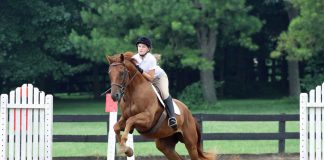
A: In many cases, a horse traveling with its head high or cocked is a problem related to training and/or behavioral issues. Yet, there are some physical concerns that should be ruled out in advance of turning this problem over to your trainer.
Horses often communicate stress or discomfort through evasive antics like the ones you mentioned. If something is hurting your mare, then she will assume a posture designed to avoid the pain. Not only do dental problems contribute to riding issues, but the type of bit and where it hits in her mouth could be troublesome despite the changes you have made. Since a hackamore is a bitless bridle, it avoids any pressure on her mouth and it’s a good tool to try to rule out a possible source of pain. This behavior may also have become a habit, which can be difficult to break.
Poor saddle fit can also cause enough discomfort that the horse will gyrate her neck and head in an attempt to escape the pain. If she is fine at the walk but not OK at faster paces, then be sure to have her saddle checked for pressure or rub points. Also, it is important to have your vet evaluate her for any lameness issues or back or neck pain that might be the root cause of her resistant behavior.
Headshaking syndrome can also cause abnormal head carriage due to sun-related facial nerve sensitivity. If she doesn’t display this behavior when ridden in an indoor arena, then it is worth having your vet pursue a diagnosis of headshaking syndrome.
Anxiety is another potential cause of postural neck carriages like this. For example, if she tends to be anxious when alone due to insecurity, or if she doesn’t like the work being asked of her, she may become resistant and braced. Wanting to go faster than she is allowed can also cause your horse to throw her head in the air to escape the restraining pressure. Please resist any suggestions to put her in a martingale or some other device designed to hold down the head. These create more bracing issues as well as posing a danger to both horse and rider.
Boredom can contribute to evasive behaviors, so it’s nice to mix up her riding lessons with different requests, like trotting cavalletti poles, riding serpentines, and asking for frequent upward and downward transitions. Also, trail riding is a pleasurable activity for most horses, as it gives them big open spaces and a lot of variety, especially compared to arena riding.
Once your vet has sorted through various physical possibilities for her behavior, find a patient and competent trainer who can help you work on modifying this behavior. It often helps to have the trainer ride the horse to determine if the problem is solely with the horse rather than a combination of horse and rider, or unforgiving hands or seat.
Nancy S. Loving, DVM, is a performance horse veterinarian based in Boulder, Colo., and is the author of All Horse Systems Go.
This article originally appeared in the January 2015 issue of Horse Illustrated. Click here to subscribe!






Sounds like it could be a lot of different issues.